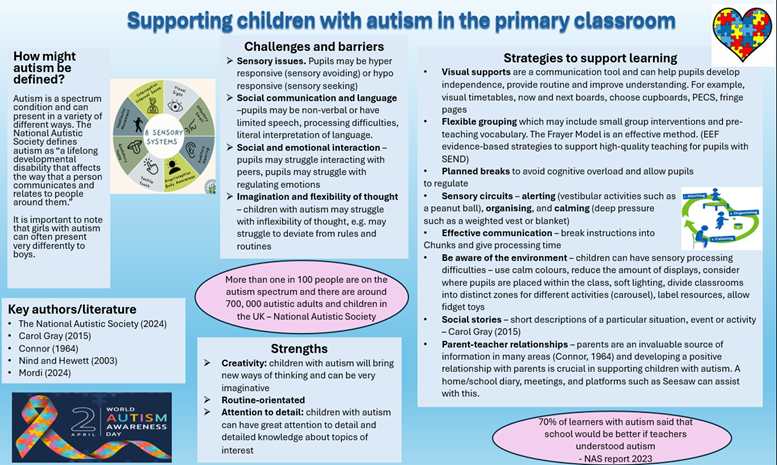Supporting Children with Autism in the Primary Classroom
- Primary
- Inclusion
- Autism
- Neurodiversity
The focus of my poster is children with autism and the poster touches on the definition of autism, strengths, challenges and strategies to support. These areas require a greater depth explanation which I will elaborate on in this section, referencing literature. The definition included in my poster was from The National Autistic Society which defines autism as “a lifelong developmental disability that affects the way that a person communicates and relates to the people around them.” I wanted to draw attention to how girls with autism present very differently and autism can often go unnoticed due to masking and ‘females are more likely than autistic males to be aware of difficulties with pragmatic, language and social behaviours’ (Sturrock et al., 2020). There are a wide range of challenges and barriers to learning that may affect children with autism which includes sensory issues, difficulties with social communication and language, social and emotional interaction, and flexibility of thought. During my inclusion placement, I encountered pupils with sensory issues and upon observation as well as discussion with expert teachers, I learnt how it can affect learning, and I also was informed about sensory circuits. Some pupils with sensory issues may be hyper responsive (sensory avoiding) or hypo responsive (sensory avoiding). Wood, et. al. (2019) asserts that ‘different types of sensory input are a deep necessity’ and if this is not accessible for children in school they might struggle to concentrate and learn. In my inclusion placement, I had the opportunity to observe and practice sensory circuit activities with pupils for alerting and calming, including the use of a peanut ball and weighted vests. After these sensory circuits, I could immediately see the positive impact on the pupil as they were able to engage in group time. This particular area intrigued me, and I wanted to further develop my knowledge of sensory issues in children with autism and ways in which pupils can be supported in the classroom. Despite these challenges and barriers to learning, there are many strengths that children with autism can bring to the classroom. Mirenda, P. et al. (2024) highlights that upon research, the strengths frequently identified were ‘love, happiness, kindness, humour, and intelligence… as well as specific strengths in academic or recreational domains.’ In my poster, one of the strengths mentioned was that children with autism will bring new ways of thinking and can be very imaginative. Secondly, children with autism can have great attention to detail and detailed knowledge about topics of interest. In addition to this, children with autism may be routine-orientated and this aligns with the structuredness of school. The literature demonstrates the numerous strengths that children with autism bring to the classroom and in turn, this suggests the importance of acknowledging the strengths that children with autism have rather than solely fixating on the challenges. This draws parallels to the positive psychology framework which strives to ‘understand and build the factors that allow individuals, communities, and societies to flourish’ (Seligman & Csikszentmihalyi, 2000). This suggests that a strength-based approach for children with autism may help them in the primary classroom as there is both an acknowledgement of challenges and potential barriers to learning and thinking of the best way for them to thrive in the primary classroom through consideration of their strengths. The largest section of my poster was strategies to support learning in the primary classroom for children with autism. Visual supports are a communication tool and can help pupils develop independence, provide routine and improve understanding. On my inclusion placement I observed now and next boards to assist with transitions, choose cupboards, and fringe pages that were created for each lesson or activity and had key vocabulary accompanied by images. Whilst these resources on their own are useful, the child and adult interaction can make these visual supports more effective. Pupils need to be shown how to use visual supports consistently and ‘noticing and rewarding children using visual supports can be powerful’ (Mordi, 2024 p.77). Another technique that I have researched and observed during my inclusion placement is intensive interaction which ‘develops the fundamentals of communication through playful, relaxed interaction where the adult responds gently to the young person (Nind & Hewett, 2003). In my inclusion placement, there was a pupil with autism and was at a very early stage of communication development. Teacher A mirrored the pupil’s actions and sounds which led to the pupil engaging with the adult. This child-led approach helps to develop social interaction and create connection. Whilst there are barriers to learning for children with autism, there are many strategies that can be implemented into the classroom. These strategies, however, are not solely for children with autism, as they can benefit all pupils. EASNI (2020) asserts that ‘many SEN-based interventions can provide effective strategies for the whole student cohort, such as breaking down information into bite-size chunks or using visual reminders to back up instructions.’ This demonstrates that inclusive strategies can extend the learning for all learners
As I move into my next teaching placement, I plan to build on my professional understanding of inclusive educational practice by further practicing and refining strategies for making the classroom an inclusive environment for all learners. I endeavour to ensure equity, diversity and inclusion are a central focus in my classroom by implementing effective strategies and celebrating pupils’ differences. As part of my professional development, I would also like to learn more about supporting children with sensory needs and the use of sensory circuits. In order to achieve this, I will liaise with the school’s SENDCO and expert teachers as well as continually reflect on my lessons and planning to ensure that I maintain high expectations for all pupils, and I am meeting the individual needs of every child. This will assist me in creating a collaborative, supportive classroom environment which will enhance the learning experience and progress of pupils.

